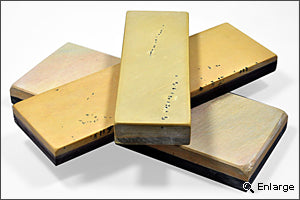
Hone Basics: Natural vs. Synthetics
Natural Hones
Natural stones are defined as those that are not manmade. They are mined from the earth, so in other words they are actual rocks. Some of the names that might sound familiar are Coticules, Eschers, Thuringens, Arkansas, or Japanese Naturals.
Usually when you purchase one, you receive a main stone as well as a slurry stone, which is a smaller stone of the same material. When the two stones are rubbed together with water the byproduct is slurry, a thin mixture of water with the particles of the two stones rubbing together. Using a slurry stone on the main stone creates slurry, which aids in the removal of steel in order to achieve keenness. The slurry is used to speed up the honing process, so that as you progress you basically dilute the slurry and finish on water. Unlike most naturals that have no set grit, Japanese stones are a bit different in that their slurry stones actually are different grits, and it is the slurry stone that is primarily responsible for the sharpening.
Synthetic Hones
Synthetic hones are manmade. Some of the names that might be familiar are Norton, Shapton, and Naniwa.
The advantage to using a synthetic is a more reliable stone because, for example, when you order a 1k stone, you get a 1k stone. There is no guessing game in the grits. Another consideration is that they are a more consistent hone because certain variables that might arise with the naturals are not an issue.
When honing a straight razor with synthetic hones to restore an edge, this is accomplished by using progressive stones. The most popular grits are 1k, 4k, 8k, 12~16k. Anything above 8k is for pure polishing and smoothing out the edge. One should be able to shave with an 8k edge. On the other hand, honing with a natural is currently at the center of a heated debate. There are those that subscribe to the view that everything can be done with one stone. By first raising slurry on a coticule/escher, the honing process will begin sharpening the blade and throughout the progression the slurry is lightened until it is only water. Men often will use a synthetic hone for bevel setting, which is accomplished at the 1k or lower level. Again, some people will use synthetics for the entire honing process, and then switch to a natural for the finishing in order to achieve a smooth finish.
Which to Choose?
If you are on the fence about whether to purchase natural or synthetic hones, you should send your razor to be honed by one or the other and compare the shave. If you shave with a razor honed with a synthetic and then a natural, odds are you will feel a bit of a difference. Natural stones typically provide a smoother, less aggressive shave, while the synthetics are a crisper, brisk edge. In all, both have their advantages and disadvantages. Each type of hone will be a challenge to learn properly, but you will be rewarded the satisfaction of sharpening your own straight razors and enjoying your morning shaves.
RELATED ARTICLES...
Straight Razor Honing Video
How can I keep a sharp edge on my straight razor other then a basic stropping?
How do you strop a straight razor?





Leave a comment